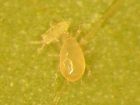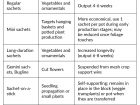
Features
Biocontrols
Inputs
IPM update: 1001 ways to use predatory mites
There are many species of predatory mites and different formulations. Which do you choose and how do you obtain maximum performance in your greenhouse crop?
August 8, 2017 By Drs. Rose Buitenhuis and Michael Brownbridge
August 2017, Vineland Station, Ont. – This is part four in a six-part series of articles on thrips (and other pests) integrated pest management, where we will provide practical application tips and tricks, information on new technologies and how it all fits within an overall IPM program. Each article will be accompanied by a short video demonstrating a technique or principle.
The content of this series is based on research performed at Vineland Research and Innovation Centre and is supplemented with ‘information from the field,’ contributed by colleagues using biocontrol strategies in greenhouse production.
For more information on specific biocontrol agents or IPM in general, see www.greenhouseIPM.org.
Predatory mites were some of the first commercially produced biocontrol agents. For example, Phytoseiulus persimilis has been around for 50 years. Other workhorses such as Neoseiulus (formerly Amblyseius) cucumeris and Neoseiulus californicus were commercialized in the 1980s and still are important components of biocontrol programs today.
After parasitic wasps, predatory mites are the most commonly used biocontrol agents. According to a list compiled by Van Lenteren and colleagues, there are now about 45 predatory mite species available as biocontrol agents worldwide. About one third of these were introduced onto the market in the last 10-15 years.
Commercially available predatory mites vary between specialist spider mite predators and generalist species that prey on a multitude of pests. Some also feed on plant sap, pollen or nectar. Some like plants with smooth leaf surfaces, others like their plants to be more hairy. Obviously, one mite does not fit all situations. The more we know about them, the better we can choose the right mite for each crop and location, and make sure we keep them happy so they will perform to the best of their capacities.
In greenhouse crops in North America, we are most familiar with the predatory mites that prey on spider mites (e.g. P. persimilis, N. californicus), thrips (N. cucumeris, Iphiseus degenerans, Stratiolaelaps scimitus, Gaeolaelaps sp.), and the more polyphagous species (Amblyseius swirskii, Amblydromalus limonicus) whose prey includes spider mites, thrips and whiteflies. Most of these species will also munch on other pest mites or fungus gnats. Here, we will concentrate on predatory mites for thrips control. Note that many of these species have had their scientific name changed over the course of the years and often the old names are still used in the industry.
Predatory mite species: In 2013, Laura Hewitt, a master’s student at the University of Guelph, compared N. cucumeris and A. swirskii for control of thrips in winter and summer. She found that A. swirskii (Fig 1) provided superior control of thrips than N. cucumeris in summer, probably because A. swirskii survives the hot conditions better. In winter, control by either predator was similar. The experience of Ontario growers over the past few years validates these results. Growers generally find A. swirskii to the better predator in summer, although in some crops the cost of A. swirskii is too high and growers use N. cucumeris year-round.
Amblydromalus limonicus is the newest predatory mite on the North American market. Contrary to A. swirskii and N. cucumeris, A. limonicus also eats the larger, second instar thrips larvae and is active at lower temperatures. It can survive on pollen and other prey species such as whiteflies. However, A. limonicus is currently three times the cost of A. swirskii. Although Dr. Sarah Jandricic (OMAFRA) found it shows good potential for whitefly control on crops like mandevilla and gerbera in the cooler winter months, the less expensive N. cucumeris may still be the grower’s best choice against thrips.
Iphiseius degenerans has been around for many years, but seems most effective in crops producing pollen, like peppers. Due to its higher cost, it is not economical to do multiple augmentative releases using large numbers of I. degenerans in non-flowering or late blooming crops. In the past, growers in the Netherlands experimented with Ricinus banker plants to breed this predator directly in the greenhouse and now with the increasing popularity of pollen as supplemental food for predatory mites, I. degenerans may experience a comeback. We’ll have more about these methods later on in this article.
All these predatory mites attack the first – and sometimes second – larval stages of thrips. However, mites have other tricks up their sleeves: did you know that some also eat thrips eggs? Thrips females embed their eggs into the leaf tissue, making them hard to reach with sprays. However, researchers at Biobest Belgium determined that predators like I. degenerans, N. cucumeris and A. swirskii can consume 3-4 thrips eggs per day, particularly when eggs are just about to hatch and protrude slightly above the surface of the leaf. Yet, when given the choice, A. swirskii preferred to prey on thrips larvae. These researchers also indicated the potential benefits of this egg predation behaviour for management of other thrips species, such as Echinothrips.
Predatory mites can also affect thrips stages that are too large to kill. Dr. Sarah Jandricic (OMAFRA) found that harassment by N. cucumeris reduced feeding by second instar thrips larvae and consequently plants showed less damage. In addition, harassed thrips adults laid fewer eggs and did not live as long as their unharassed counterparts, with resulting effects on thrips population growth.
Stratiolaelaps and Gaeolaelaps sp. are soil-dwelling predatory mites that attack thrips pupal stages, so they are a good complement to the other predators that generally go after the foliar thrips stages. Because these mites can survive on a variety of prey sources, they can persist in the growing medium for many weeks even in the absence of pest prey such as thrips or fungus gnats. Therefore, they are only applied once for a short-term crop, soon after planting. These mites provide some control of thrips in hydroponically grown crops, but they are most effective in crops grown in potting media.
Formulations and release strategies: Predatory mites come in different types of packages, which represent different ways of releasing them in the crop:
Bulk material usually comes as a tube or bucket with predatory and food mites mixed in a carrier material like bran or vermiculite. These materials are intended to be broadcast over the crop by hand or using a mechanical device like a blower. Another option is to make little piles of material on the substrate (breeder piles), although this method is not very popular anymore and has largely been replaced by the use of sachets.
Slow release sachets (Fig. 2) contain predatory mites of all life stages mixed with bran and a food mite at high ratios (e.g. one predator to about 10 food mites). The mites (both predatory and feeder mites) breed within the sachet, ensuring a constant supply of predatory mites into the crop over several weeks. There are many variations on the sachet-theme, depending where they are applied (Table 1, Page 32). You can find more information on the pages of www.greenhouseipm.org, or check out this article http://www.gpnmag.com/article/effective-release-methods-of-predatory-mites/.
One development that is worth mentioning are the new sachets for A. swirskii that Koppert will soon launch in North America. These sachets are made of a new material and have been developed for use at low relative humidity (where paper sachets do not perform well), or outdoors as the material used for the sachets protects the contents from the weather. In addition, the sachets are biodegradable.
Many growers like to have an idea of the quality of the biocontrol agents before they release them in the greenhouse. For predatory mites in bulk-formulation, it is easy to see if the predators are alive and numerous. Simply mix the product well and spread a few small samples on a sheet of white paper. If you shine a bright light on it, you will see the predatory mites (fast runners) and food mites (slow walkers) moving around.
For sachets, the initial number of mites in the sachet at receipt is quite misleading because the mites will be reproducing and the final output of the sachet should be measured over the lifetime of the sachets. The best measure of performance and quality is to monitor the weekly walk-out. Previous methods such as described in the Grower Guide: quality assurance of biocontrol products (http://vinelandresearch.com/sites/default/files/grower_guide_final_version.pdf), suspend a sachet over a sticky card, but the mites will be easier to count if the sachet is hung over a dish of soapy water (Fig 3). Place the apparatus in the greenhouse in locations where sachets would normally be hung, so they are exposed to the same conditions. This will give a realistic measure of how the sachets are performing in the crop. Top up the soapy water as needed. Count the mites in the water twice a week. The predatory and food mites are easy to distinguish from each other under a microscope.
Alternatively, hang the sachets in a covered bucket containing a saturated NaCl (table salt) solution and hold at room temperature. The salt solution creates a relative humidity of 75 per cent inside the bucket and will provide a measure of the performance of the sachets under optimal conditions.
Keep in mind that how and where the predatory mites are released will influence their performance. Bulk product that falls on the ground or between pots should be considered lost. The mites will not walk long distances over hostile terrain (e.g. plastic or substrate). On plants, they spread through the crop on the foliage. If the canopies of neighbouring plants are not touching, predatory mites will not move among plants but will remain close to the release plant. For slow release sachets, it is especially important to place them inside the canopy, or a shaded area, not hung on the outside of a hanging basket in the full sun. The mites need high relative humidity (above 60 per cent) to breed and to ensure a continuous output of predators into the crop over the course of several weeks. If sachets are held in direct sunlight, humidity inside the sachets is generally too low and the internal temperature too high for sustained production.
Keeping your predators happy: Now that you have chosen the right predatory mite, you checked their quality and made sure you released them in the right way and in the right place, what else can you do to optimize their performance? When predatory mites are released in a preventive strategy, many of them will die, necessitating repeated introductions to maintain a population of predators in the crop to protect against invading thrips.
One method to retain and even increase numbers of predatory mites in the crop is to feed them with supplemental food. Biobest sells cattail pollen under the name Nutrimite that can be blown over the crop. Israeli researchers patented an elegant method to supplement plants with pollen while at the same time providing predatory mites with a place to lay their eggs, called the “pollen-on-twine” method. Other options are to provide mites with de-capsulated brine shrimp (Artemia) eggs or flour moth (Ephestia) eggs. Several researchers in Europe are even experimenting with releases of food mites (the same or similar to those used in mass rearing) in the crop or on the substrate.
Banker plants, plants that provide alternative food and/or a breeding site for biocontrol agents, are also an option, although rarely used much for predatory mites. In the ‘90s, innovative Dutch growers used Ricinus plants as banker plants for I. degenerans. More recently, research in Florida has investigated several ornamental pepper varieties as bankers for A. swirskii. It is also possible to turn an attractive variety or plant species in the greenhouse into trap plants and to concentrate release of predators on
these plants.
Integration with other bios and IPM strategies: Biocontrol agents do not always play nicely together and some should not be combined. In the laboratory, different species of predatory mites are able to kill each other for food, potentially interfering with pest control. Yet, this does not mean that these interactions will occur or be significant in a commercial crop. Predators may be able to coexist if they have different foraging strategies, plant or habitat preference or defence/avoidance mechanisms.
In other cases, predatory mites clearly have a negative effect: Both A. swirskii and N. cucumeris consume eggs of the aphid predator Aphidoletes aphidimyza, which can cause aphid densities to increase significantly. In contrast, Orius predators can be safely used together with predatory mites and/or entomopathogenic fungi such as Beauveria bassiana (BotaniGard, Bioceres) and Metarhizium brunneum/anisopliae (Met52). In fact, recent work by Gongyu Lin, a student at the University of Montreal, shows that A. swirskii, N. cucumeris and Stratiolaelaps sp. can safely accumulate and carry Bioceres® (B. bassiana strain ANT-03) on their bodies. Similar to bee vectoring of biopesticides, the idea is to use mites to disseminate the fungus over the plants to provide additional thrips control, especially of developmental stages that the mites cannot kill. The next steps in this research are to determine the level of thrips infection and control obtained in a greenhouse setting.
Conclusion: A tool is only as good as the person using it. When used properly, predatory mites are one of the pillars of thrips control. Together with nematodes, fungal biopesticides and other predators such as Orius they will deliver good thrips control.
Click here for a video that accompanies this feature – “Monitoring the weekly ‘walkout’ from slow-release sachets.”
We hope you are looking forward to the next article in this series. We appreciate feedback, so if you have any suggestions for topics or comments, please let us know (Rose.Buitenhuis@vinelandresearch.com, Michael.Brownbridge@vinelandresearch.com).
Print this page



